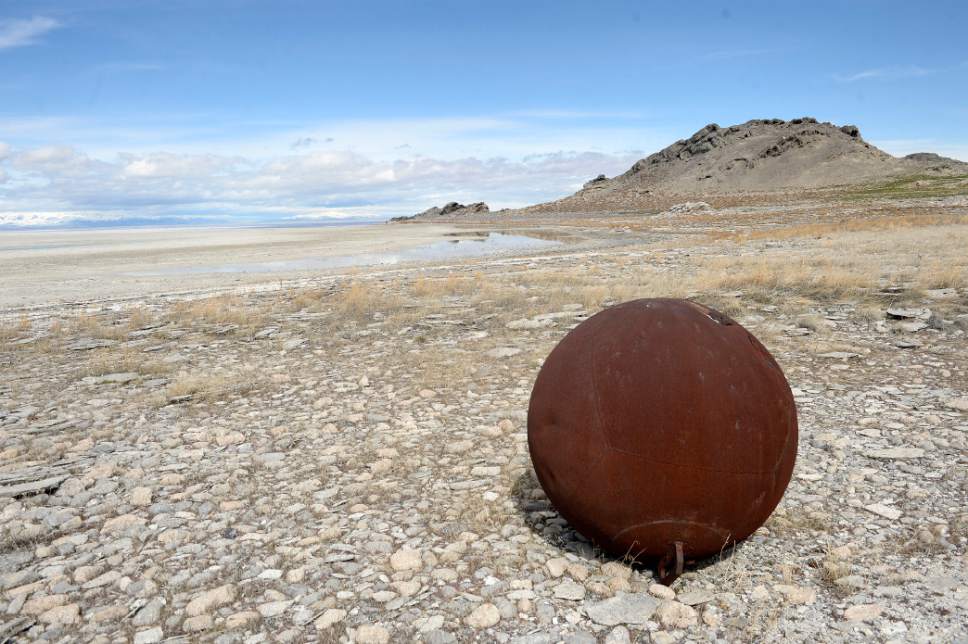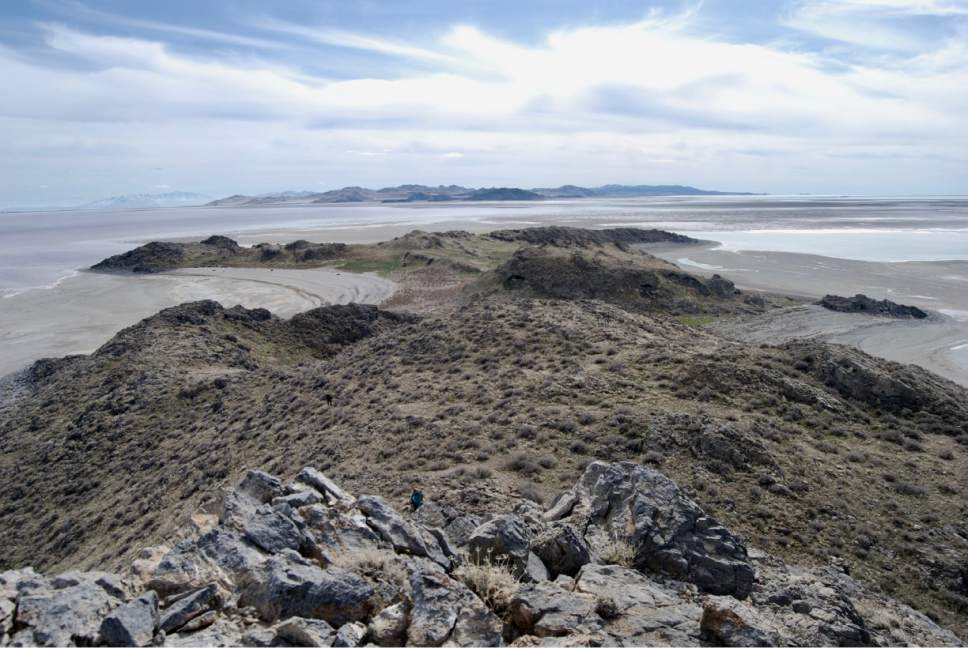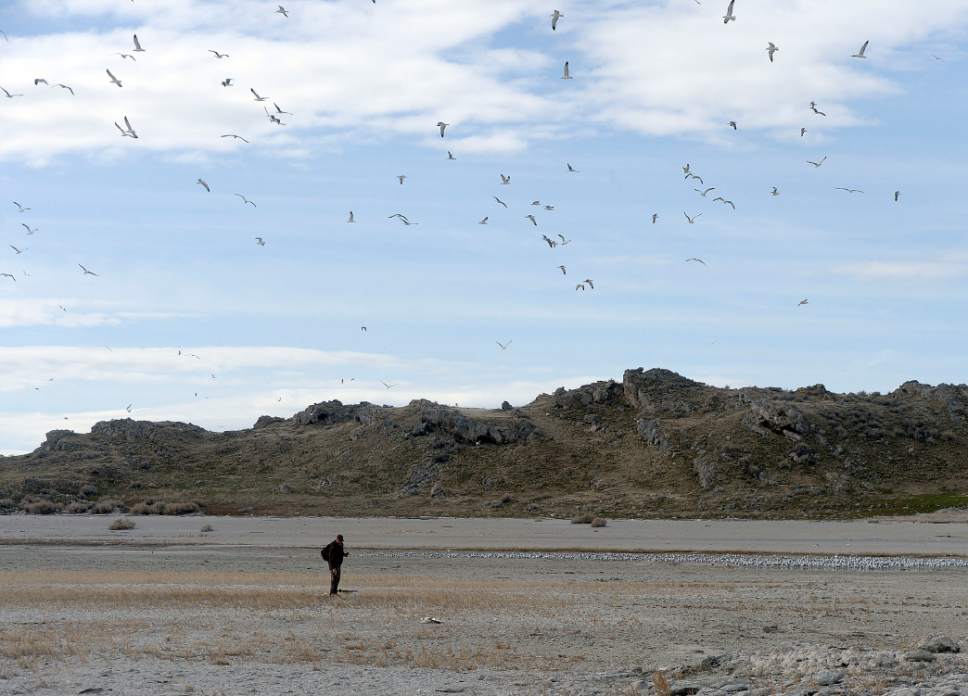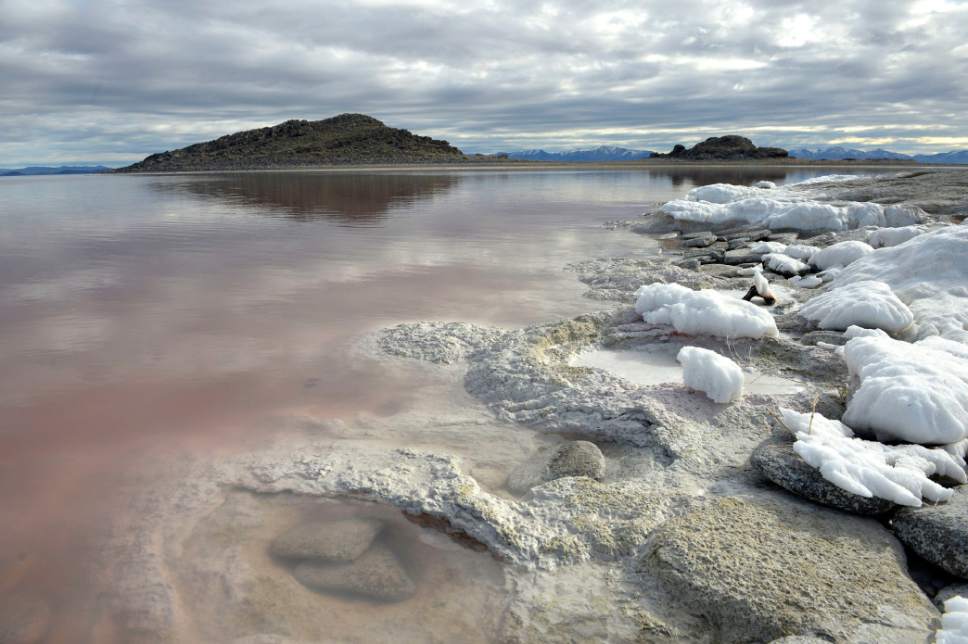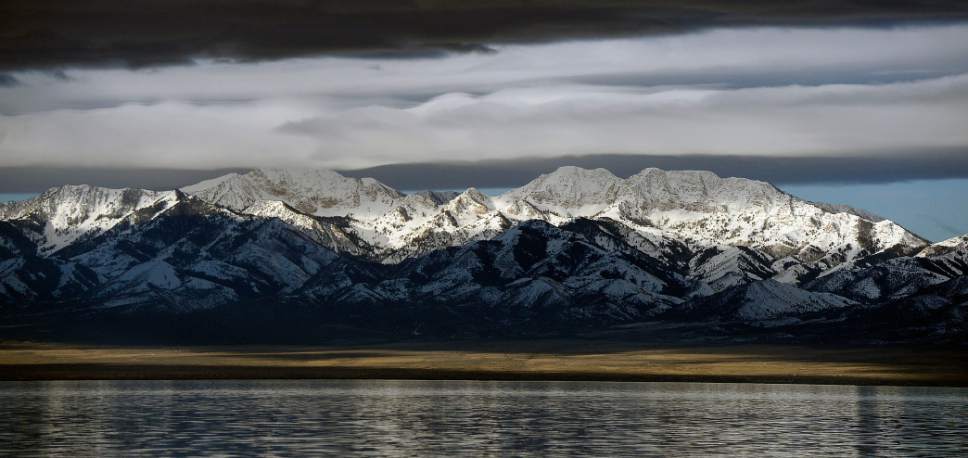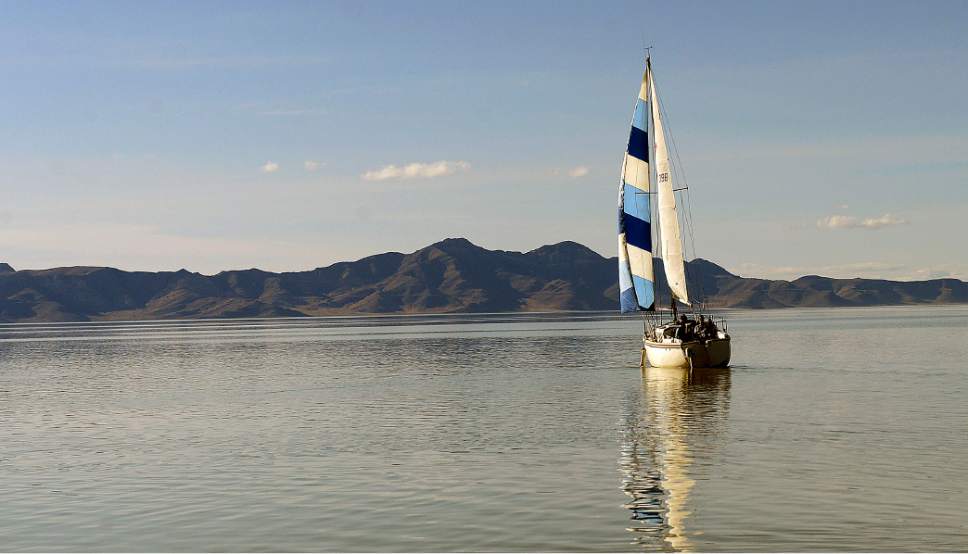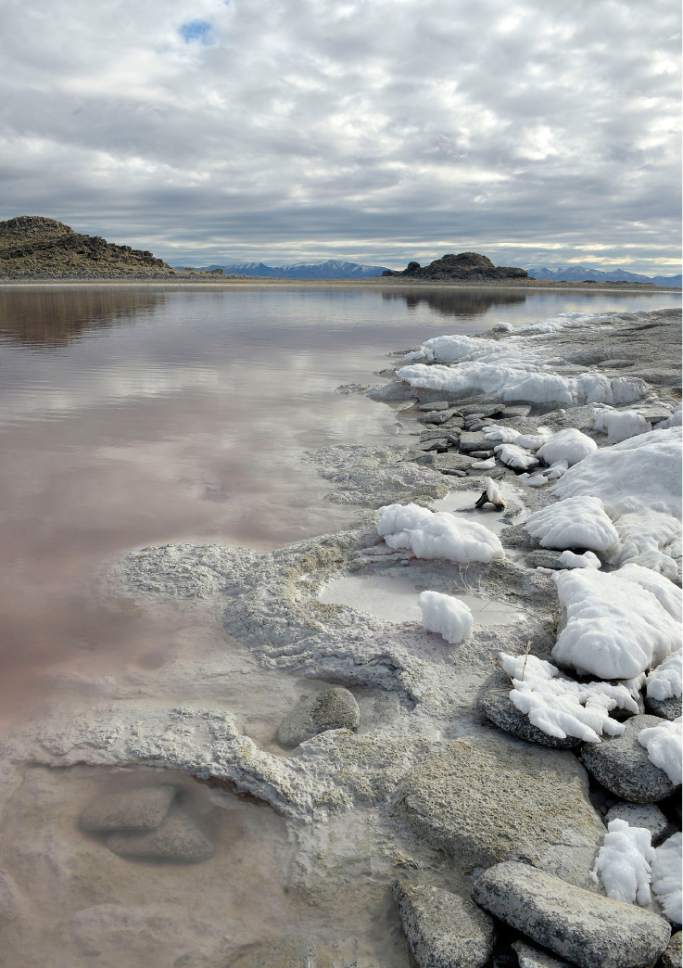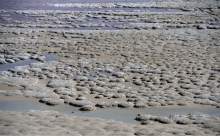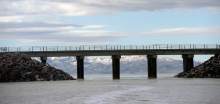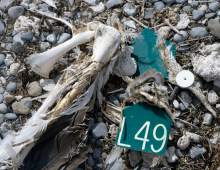This is an archived article that was published on sltrib.com in 2017, and information in the article may be outdated. It is provided only for personal research purposes and may not be reprinted.
Gunnison Island, Box Elder County >> Unless you count migratory birds as company, the loneliest places in Utah are the tiny salt-encrusted islands poking above the red surface of the Great Salt Lake's North Arm.
The public isn't even allowed to boat within a mile of the 155-acre Gunnison Island, home to one of North America's largest breeding colonies of American white pelican, the largest of the 250 species of water fowl that depend on the Great Salt Lake.
But officials with the Utah Division of Wildlife Resources, in partnership with academic researchers, ventured onto the irregularly shaped mile-long island this month to install cameras in various locations — to not only observe the breeding pelicans without disturbing them, but to surveil for coyotes and foxes.
Biologists say the island's remoteness, far from food sources and fresh water, make it a tough place for pelicans to raise their young, but its isolation is perfect for deterring the intrusions pelicans cannot tolerate.
After the Great Salt Lake dipped to a new historic low last year, Gunnison's isolation is no longer assured and four-footed predators have been observed roaming the island's south shore.
A big concern is that just a few predators could make pelicans abandon the island.
With private grants that paid for the photographic equipment, Westminster College's Great Salt Lake Institute is coordinating the research, which will yield hundreds of thousands of images that researchers hope the public will help analyze.
"We have more questions than we have answers, and so if we can actively watch them and see what they are doing every five minutes we will answer some really cool questions," said institute coordinator Jaimi Butler.
Researchers envision crowd sourcing the stream of new data to Utah teachers, students and the general public.
"Tell us if you see coyotes. Tell us when you see the birds come in," said Butler. "The goal is to connect the people who live on the Wasatch Front to these charismatic birds."
—
Fecal riches • In 1896, artist Alfred Lambourne made his famous hermitage on Gunnison Island, growing grapes in hopes of establishing a "homestead." Lambourne resided on a bay on the island's east shore that now bears his name, but his solitude came to an end that spring with the arrival of thousands of gulls and pelicans, as well as swarthy human characters who mined the fecal riches deposited by the birds.
Lambourne made the best of the disruption by drawing the men he called "guano sifters."
They would eventually file for a mining claim on the excrement, which can be sold as fertilizer, effectively claiming title to the northern half of the island, even though their activity scared off the pelicans, according to Dale Morgan's "The Great Salt Lake."
Without pelicans, there was no more mineral wealth to harvest so the sifters gave up on the island, which nonetheless passed into private hands, where it remained until the 1980s when the state acquired it as a bird preserve.
Lambourne's vineyard didn't make it and after 14 months, friends sailed to the island to ferry the artist back to civilization. The birds soon returned to Gunnison to reclaim the nesting grounds in solitude.
This month, pelicans are again flying back to Utah from wintering range on the Pacific Coast for their annual mating and nesting sojourn on Gunnison, where up to 20,000 adults converge every March for the 12-week breeding cycle.
Up to 5,800 nests appear on Gunnison's shorelines every spring when mature adults arrive and form "subcolonies," or groups of nests close enough to offer a protection but far enough so that nesting birds can't hit each other.
On March 8, just ahead of the birds' arrival, DWR led a research excursion to the island to rig a dozen cameras and sweep the shores for the carcasses of juveniles that had been tagged over the past five years, gathering the green tags from their dessicated wings and coded bands from their legs.
—
Another world • Three Department of Natural Resources boats took the team from the Great Salt Lake Marina to the island, a two-hour journey that passed though the new breach in the Union Pacific causeway separating the northern Gunnison Bay from the rest of the lake.
The boats beached on the island's north shore where the lake bed drops more precipitously, enabling the crafts to touch the shoreline.
The North Arm's hypersaline waters produce salt crystals when the shallow waters cool in the winter, forming rock-hard mounds along the shore. Low water has exposed thousands of bioherms, rocky structures formed by microbial life that thrive in the lake.
Gear was off-loaded and the research team broke into groups to hump cameras and materials around the island and sweep the shore for dead birds bearing green tags.
University of Utah atmospheric scientists Luke Leclair and Alex Jacques installed what is called PELIcam, a camera taking in all of Lambourne Bay and recording an image every five minutes that will be posted on the web in real time.
Operators can zoom if they see something interesting, but it cannot pan. The camera enables researchers and the interested public to see what's going on at Lambourne Bay as the lake level comes up and weather blows in and out through the breeding season, when the bay becomes a hive of avian activity.
Biologist John Luft, who directs DWR's Great Salt Lake Ecosystem Program, said cameras will offer invaluable glimpses of how pelicans breed, nest, lay eggs and how sub-colonies of the birds form and grow across the island's otherworldly landscape.
Perhaps more crucially, Luft said as seagulls swirled above him, "we will also see time frame when [fledglings] are left on their on own, when they are okay to be left by both adults without falling prey to all these gulls."
Thousands of gulls were already milling around on the bay's shore as researchers landed and fanned out. Seemingly out of nowhere, a group of six pelicans flew overhead, crossing the island without landing. A coyote appeared on the south shore and moved away from one research group, only to be spotted by another.
Jacques insisted the camera be installed on Lambourne Bay's north end so it can be trained south, away from spring storms that could obstruct its lens with snow. So researchers settled on a site up a rocky hill rising from island's north end. The other cameras are small motion-triggered units secured to stakes four feet off the ground, close to the nesting areas and at pinch points where a coyote would pass.
Near the end of breeding season in July, DWR returns to the island to round up hundreds juvenile birds to place large green tags on each wing and a coded metal band around a leg. Over the past five years, hundreds of birds have been tagged, but until the March 8 trip the tags had never been systematically gathered up.
When researchers return in July, they will replace the cameras' batteries and retrieve their memory cards, recovering what is hoped to be a rich trove of visual data.
—
Strange birds • Pelicans are hardly the most plentiful among bird species drawn to the Great Salt Lake but they are the most distinctive. At 10 to 20 pounds with a 10-foot wingspan, they are equipped with a pouch on a long bill used for scooping up fish and a dagger-like tooth at the end of their beak.
The late Fritz Knopf studied the birds back in the 1970s as a graduate student at Utah State University, providing some of the seminal scientific insights into the white pelican. He noticed nearly all nests produced two eggs, yet only one-fourth of the nests successfully fledged a single bird.
That is not surprising, said Luft, DWR's Great Salt Lake biologist, since the island is a hot, exposed place with no cover or food.
"When the birds are ready to fledge, they have to make it 30 miles to get to the closest place to fish," he said. "If they go to Bear River and it's dry and they have to go another 20 miles up to Strawberry. That's a long way to travel." In the meantime, one parent has to babysit the nest, so they take turns foraging. "One has to be right on nest to fend off gulls," Luft said. "They will peck the eggs or kill the chicks if they leave."
Knopf observed that three days is the longest a pelican will remain on the nest without being relieved.
"They are not going to sit down and die, and they leave," said Luft. "As soon as they are gone, it's over for that nest."
—
Where's Waldo? • Satellite trackers are the most effective way to monitor these migratory bird movements. Strapped to the backs of adult pelicans, the solar-powered GPS units transmit periodic way points so researchers can know where they have been.
DWR hopes to eventually rig 71 pelicans with transmitters, which have so far been placed on 32. Only 11 are currently transmitting and you can follow their movements on DWR's PeliTrack web site.
But such projects are costly. The units cost $4,000 and each incurs $200 a month in data costs. A low-cost alternative is tags and bands.
Knopf's early banding efforts did not yield much information because pelicans have not been targeted by sport hunters, who can be relied on to mail in the bands recovered from the birds they shoot.
Pelicans can live up to 20 years and tend to die in places where the carcasses are not easy to find.
But on Gunnison, dead juvenile pelicans litter the shores. Luft's research team scoured Lambourne Bay, poking every carcass they came across to see if it bore a tag or band. Dozens were recovered. For each, the coordinates and tag number were records, along with the condition of the carcass.
While Knopf's banding was a bust, he did get bands returned from Mexican commercial fishermen, who tired of competing with the birds for fish and shot them.
"That was all the returns he would get," Luft said. "Things have changed since then. That's frowned upon."
For years Utah fishermen also assumed pelicans dined on game fish in Bear River Bay and pressured the state to do something about it. In 1918 the Utah Department of Fish and Game obliged and clubbed several thousand pelicans to death, according to Morgan's book.
It was a needless slaughter, yet to this day sport fishermen complain about pelicans, even though stomach analyses reveal that they feed on carp, chub, suckers and other "trash" species.
These days, state wildlife officials have a broader mission, carefully protecting and studying pelicans to ensure these strange travelers keep returning to Utah.
Brian Maffly covers public lands for The Salt Lake Tribune. Maffly can be reached at bmaffly@sltrib.com or 801-257-8713.
Twitter: @brianmaffly


